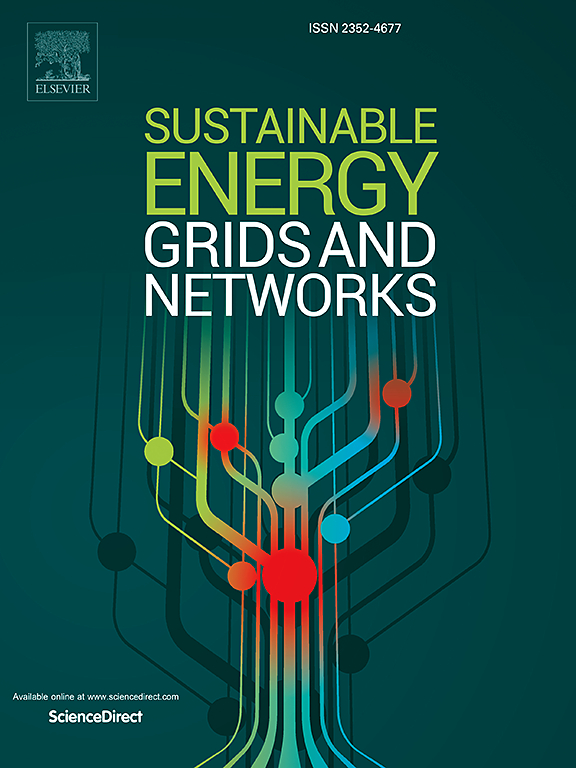Edge-level explainable graph neural networks with network centric features for transmission line failure prediction in power grids
IF 5.6
2区 工程技术
Q2 ENERGY & FUELS
引用次数: 0
Abstract
Cascading outages in high-voltage power grids pose a severe risk, causing blackouts with global economic losses estimated at billion annually. These outages disrupt economic activity and impact energy efficiency and sustainability goals by necessitating less efficient backup generation and hindering the integration of renewable energy sources. This paper introduces a pioneering, explainable Graph Neural Network (GNN) framework for edge-level transmission line failure prediction, addressing a critical gap in grid resilience analytics. Our work presents two key innovations: first, it is the first framework of its kind to be systematically validated across four standard power grid benchmarks (IEEE-24, 39, 118, and the UK grid), demonstrating robust generalization. Second, it advances an interdisciplinary approach by uniquely integrating network science principles with deep learning, augmenting traditional electrical data with topological descriptors like betweenness centrality and load ratio. This fusion enhances the predictive power of three GNN architectures: GINE, GAT, and EdgeAwareGC. On the IEEE-24 test system, this integration boosts macro-F1 scores from 0.498 to 0.871 for EdgeAwareGC and from 0.335 to 0.859 for GINE. This scalability and effectiveness are further demonstrated on the highly imbalanced IEEE-118 network, where EdgeAwareGC achieves a strong F1 score of 0.553. Explainability techniques such as gradient-based attribution and GNNExplainer uncover key physical and topological predictors, providing actionable guidance for grid operators. Our findings inform grid modernization policies, supporting initiatives like the U.S. Department of Energy’s Grid Resilience and Innovation Partnerships (GRIP) program. This work highlights the potential of GNNs to substantially improve power system reliability, contributing to more sustainable and efficient energy infrastructure, and aligning with global efforts toward decarbonization and enhanced energy security.
基于网络中心特征的边缘可解释图神经网络在输电线故障预测中的应用
高压电网的级联停电构成了严重的风险,造成的停电每年给全球造成的经济损失估计约为1000亿美元。由于需要低效率的备用发电,并阻碍可再生能源的整合,这些停电破坏了经济活动,影响了能源效率和可持续性目标。本文介绍了一种开创性的、可解释的图神经网络(GNN)框架,用于边缘级传输线故障预测,解决了电网弹性分析中的一个关键空白。我们的工作提出了两个关键的创新:首先,它是同类框架中第一个在四个标准电网基准(IEEE-24、39、118和英国电网)上进行系统验证的框架,展示了强大的泛化能力。其次,它通过独特地将网络科学原理与深度学习相结合,利用拓扑描述符(如中间性中心性和负载比)增强传统的电气数据,提出了一种跨学科的方法。这种融合增强了GINE、GAT和EdgeAwareGC三种GNN架构的预测能力。在IEEE-24测试系统上,这种集成将EdgeAwareGC的宏观f1分数从0.498提高到0.871,将GINE的宏观f1分数从0.335提高到0.859。这种可扩展性和有效性在高度不均衡的IEEE-118网络上得到了进一步的证明,EdgeAwareGC的F1得分达到了0.553。可解释性技术,如基于梯度的归因和gnexplainer,揭示了关键的物理和拓扑预测因子,为网格运营商提供了可操作的指导。我们的研究结果为电网现代化政策提供了信息,支持了美国能源部电网弹性和创新伙伴关系(GRIP)计划等举措。这项工作强调了gnn在大幅提高电力系统可靠性、促进更可持续和高效的能源基础设施以及与全球脱碳和加强能源安全努力保持一致方面的潜力。
本文章由计算机程序翻译,如有差异,请以英文原文为准。
求助全文
约1分钟内获得全文
求助全文
来源期刊

Sustainable Energy Grids & Networks
Energy-Energy Engineering and Power Technology
CiteScore
7.90
自引率
13.00%
发文量
206
审稿时长
49 days
期刊介绍:
Sustainable Energy, Grids and Networks (SEGAN)is an international peer-reviewed publication for theoretical and applied research dealing with energy, information grids and power networks, including smart grids from super to micro grid scales. SEGAN welcomes papers describing fundamental advances in mathematical, statistical or computational methods with application to power and energy systems, as well as papers on applications, computation and modeling in the areas of electrical and energy systems with coupled information and communication technologies.
 求助内容:
求助内容: 应助结果提醒方式:
应助结果提醒方式:


